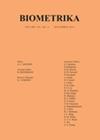Projective Independence Tests in High Dimensions: the Curses and the Cures
IF 2.8
2区 数学
Q2 BIOLOGY
引用次数: 2
Abstract
Summary Testing independence between high dimensional random vectors is fundamentally different from testing independence between univariate random variables. Take the projection correlation as an example. It suffers from at least three issues. First, it has a high computational complexity of O{n3 (p + q)}, where n, p and q are the respective sample size and dimensions of the random vectors. This limits its usefulness substantially when n is extremely large. Second, the asymptotic null distribution of the projection correlation test is rarely tractable. Therefore, random permutations are often suggested to approximate the asymptotic null distribution. This further increases the complexity of implementing independence tests. Last, the power performance of the projection correlation test deteriorates in high dimensions. To address these issues, we improve the projection correlation through a modified weight function, which reduces the complexity to O{n2 (p + q)}. We estimate the improved projection correlation with U-statistic theory. More importantly, its asymptotic null distribution is standard normal, thanks to the high dimensions of random vectors. This expedites the implementation of independence tests substantially. To enhance power performance in high dimensions, we introduce a cross-validation procedure which incorporates feature screening with the projection correlation test. The implementation efficacy and power enhancement are confirmed through extensive numerical studies.高维投射独立性检验:弊与弊
测试高维随机向量之间的独立性与测试单变量随机变量之间的独立性有本质的不同。以投影相关性为例。它至少有三个问题。首先,它的计算复杂度很高,为O{n3 (p + q)},其中n、p和q分别是随机向量的样本量和维数。当n非常大时,这极大地限制了它的有用性。其次,投影相关检验的渐近零分布很难处理。因此,随机排列常被用来逼近渐近零分布。这进一步增加了实现独立性测试的复杂性。最后,投影相关检验的功率性能在高维情况下会下降。为了解决这些问题,我们通过修改权函数来改进投影相关性,将复杂度降低到O{n2 (p + q)}。我们用u统计量理论估计改进后的投影相关性。更重要的是,由于随机向量的高维,它的渐近零分布是标准正态分布。这大大加快了独立性测试的实现。为了提高高维度下的功率性能,我们引入了一种交叉验证程序,该程序将特征筛选与投影相关测试相结合。通过大量的数值研究证实了该方法的实现效率和功率增强。
本文章由计算机程序翻译,如有差异,请以英文原文为准。
求助全文
约1分钟内获得全文
求助全文
来源期刊

Biometrika
生物-生物学
CiteScore
5.50
自引率
3.70%
发文量
56
审稿时长
6-12 weeks
期刊介绍:
Biometrika is primarily a journal of statistics in which emphasis is placed on papers containing original theoretical contributions of direct or potential value in applications. From time to time, papers in bordering fields are also published.
 求助内容:
求助内容: 应助结果提醒方式:
应助结果提醒方式:


